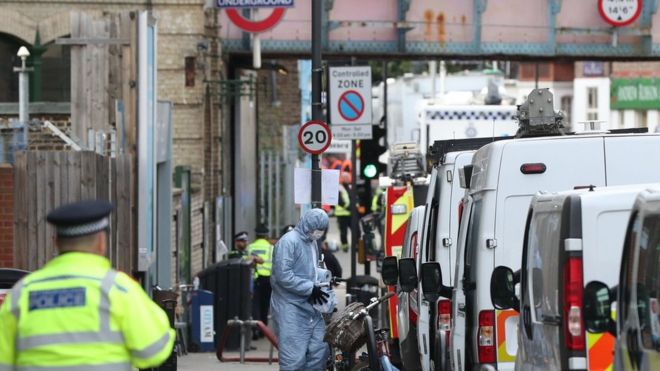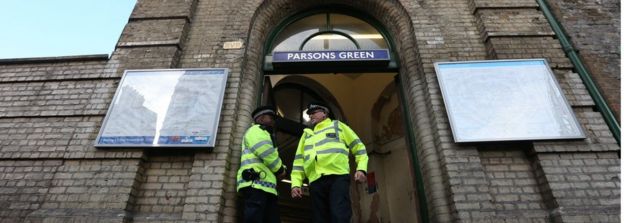Parsons Green: Man arrested over Tube bombing
 Image captionPolice have spoken to 45 witnesses so far and received 77 images and videos from the public
Image captionPolice have spoken to 45 witnesses so far and received 77 images and videos from the publicAn 18-year-old man has been arrested on suspicion of a terror offence in connection with Friday’s attack on a London Tube train.
The man was held in Dover on Saturday by Kent Police and taken to a local police station.
The arrest is “significant” but the terror threat level remains at “critical”, Metropolitan Police Deputy Assistant Commissioner Neil Basu said.
Thirty people were injured after the explosion on a train at Parsons Green.
Most people were treated for minor injuries and have been released, the London Ambulance Service said, but three people remain in hospital.
Home Secretary Amber Rudd will be chairing a meeting of the government’s Cobra emergency committee later.
-
Live: Arrest in hunt for Tube attacker
-
Reality Check: How terror threat levels work
-
In pictures: Parsons Green blast
-
Armed police patrols stepped up in Scotland
On Friday evening the UK terror threat was raised to critical – the highest level – meaning an attack may be imminent.
Mr Basu said the public should remain vigilant, as the force was not changing its “protective security measures” and extra armed officers were still being deployed.
He added: “This arrest will lead to more activity from our officers.
“For strong investigative reasons we will not give any more details on the man we arrested at this stage.”
The man is due to be moved from Kent to a south London police station later.
Operation Temperer, which involves the use of the military and was put in place after the threat level was raised, is being stepped up gradually.
Home affairs correspondent Danny Shaw said it is focused on London and the south-east of England and is being described as “light-touch”, and not on the same scale as what was seen after the Manchester Arena attack.
Mayor of London Sadiq Khan said “significant” police activity would continue over the weekend and thanked police, adding: “They are there to keep us safe”.
Analysis: A ‘critical’ change

PA
By BBC security correspondent Frank Gardner
This is the fourth time the UK national terror threat level has been raised to “critical” since the system was made public in 2006.
The last time was in May this year following the Manchester Arena bombing, when it was wrongly thought that the bomb-maker was still at large and could strike again.
In the case of Parsons Green it is perhaps surprising that it took the government so long – over 12 hours – to raise the threat level to critical, under advice from the Joint Terrorism Analysis Centre, when it was obvious the perpetrator had neither died nor been caught.
Each time the level has gone to critical, it has only stayed at this highest level of alertness for three to four days – this is partly as it involves an unsustainably high tempo for the police, intelligence and security services.
Extra patrols are mounted on the streets of London, covert surveillance is stepped up and troops are deployed to free up police officers to focus on the main effort: catching the bomber before he can plant another device.
But the very fact that yesterday’s attack took place with no warning shows this system is only a broad guide to the threat and simply reflects the latest assessment.
The BBC understands CCTV images have been obtained of the person suspected of planting the explosive device.
The Islamic State group has said it was behind the bomb, which detonated at 08:20 BST on Friday.
It is understood the device had a timer, but the BBC’s security correspondent Frank Gardner said the bomb appeared not to have gone off properly.
Had it worked as intended, it would have killed everyone around it and maimed everyone in the train carriage for life, he said.
The Met’s Assistant Commissioner Mark Rowley said it was “very routine” for the Islamic State group to claim the attack, whether in contact with those involved or not.
Police have spoken to 45 witnesses so far and have received 77 images and videos from the public.
They urge anyone with information to get in touch and to upload pictures and video to the website www.ukpoliceimageappeal.co.uk or to call the Anti-Terrorist Hotline on 0800 789 321.
Were you at Parsons Green station? Did you witness the events? If it’s safe to share your experiences then please email haveyoursay@bbc.co.uk with your stories.
Please include a contact number if you are willing to speak to a BBC journalist. You can also contact us in the following ways.
Source:BBC